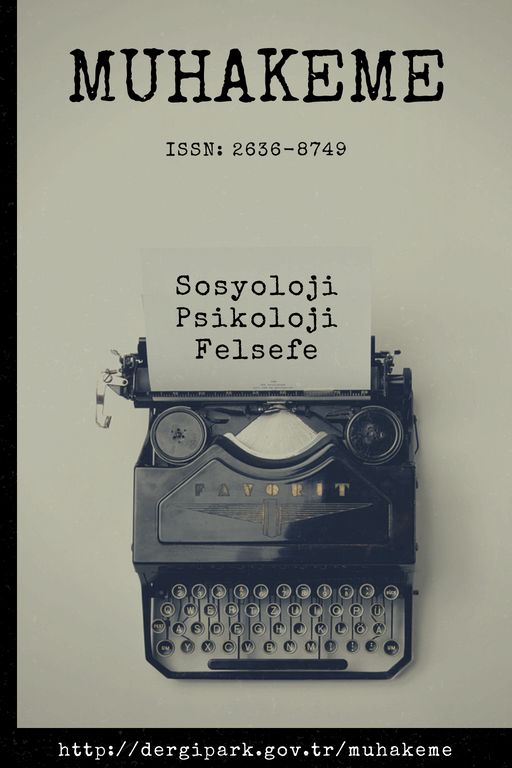Yeniden Yazma Pratiklerinde Yücenin İnşası
Bu makale yeniden yazma pratiklerinde, yüce olanın yazın mevcudiyetinin olanağını araştırmaktadır. Jean François Lyotard’ın telaffuz ettiği biçimi ile yeniden yazma post modern edebiyatın alımlanmasında kurucu bir kavram olarak anlaşılıyor olsa da, bu pratiğin aslında yazının kendisi kadar eski olduğu da iddia edilebilir. Ancak bir tekrar mekaniği, izden ime geçişi mümkün kılmaktadır. İmgeden sembole geçiş yazıyı mümkün kılan olanak olarak, düşünceye geçişi de taahhüt altına almaktadır. Sözgelişi on binlerce yıl boyunca aynı mağara duvarındaki resimlerin üzerinden geçerek resimleri canlı tutan ressam da; esrarını mesneviden aldım diyen ya da iambic pentameter ölçüsü ile sone yazan şair kadar yeniden yazma pratiğini gerçekleştirmektedir. Bu deneme yazının dolayımında anonimleşen yazar ile burada ve şimdinin algısının taşıyıcısı olarak maddi anlamda kendisine mahkûm yazar imgelerinin yazın uzamdaki karşılaşmalarının yarattığı bitimsizliği yücenin inşası olarak ele alıyor. Bu karşılaşma için yeniden yazım bir olanak yaratmaktadır. Bu, gerçek olandan düşsel olana geçişin yarattığı bir yazınsal olanaktır. Geçiş, ontolojik anlamda maddesel olanın düşünsel olana aktarımıdır. Bu aktarım yeniden yazımın yazarları arasında bir geçişliliği mümkün kılar. Makale bu yazın olayı Jorge Luis Borges ve Nathaniel Hawthorne üzerinden betimleyerek işaret ediyor.
Anahtar Kelimeler:
Jorge Luis Borges, Nathaniel Hawthorne, yeniden yazım, yüce, Alef
The Construction of Sublime in Re-writing Practices
This paper investigates the possibility of the literary presence of 'sublime' in the practices of re-writing. Even though, as Lyotard puts it, re-writing is considered a constitutive notion in the reception of the postmodern literature, one might claim that the practice of re-writing is as old as writing itself. The transition from 'trace' to 'sign' is only possible through a mechanism of repetition. The transition from 'image' to 'symbol', as what makes writing possible, also guarantees the transition from 'image' to 'thought'. As such, both the painter who retraces and thus keeps alive the drawings on the same cave walls for tens of thousands of years and the poet who writes her sonnets with iambic pentameter engage with the practice of re-writing. This essay treats the construction of the sublime as the infinity created by the encounters of the writer who is anonymized through the mediation of writing and the writer who is the bearer of the perceptions of 'here' and 'now' (and who is therefore materially restricted to herself). The practice of re-writing creates a possibility for this encounter. This is a literary possibility created by the transition from what is real to what is dreamy. The transition, in an ontological sense, is a transfer of that which is material to that which is ideal, i.e. related to thought. Such a transfer is what makes the transitivity of the writers of re-writing possible. The paper points at this literary phenomenon by describing it through the works of Borges and Hawthorne.
Keywords:
Jorge Luis Borges, Nathaniel Hawthorne, rewriting, sublime, Aleph,
___
- Borges, J.L. (2012a). Ficciones. (T. Uyar ve F. Özgüven, Çev.) İstanbul: İletişim Yayınları.
- Borges, J.L. (2012b). Öteki Soruşturmalar. (P.B Charum. ve T. Armaner, Çev.) İstanbul: İletişim Yayınları.
- Borges, J. L. (2012c). Yaratan. (A. N. Akbulut ve P. B. Charum, Çev.) İstanbul: İletişim Yayınları.
- Borges, J.L. (2013). Alef. (F. Akerson, Çev.) İstanbul: İletişim Yayınları.
- Dante, A. (1998). İlahi Komedya. (R. Teksoy, Çev.) İstanbul: Oğlak Yayıncılık.
- Derrida, J. (2008). Animal That Therefore I Am. (D.Wills, Çev.) New York: Fordham University Press.
- Derrida, J. (2010). Gramatoloji. (İ. Birkan, Çev.) İstanbul: Bilgesu Yayınları.
- Derrida, J. (2012). Platon’un Eczanesi. (Z. Direk, Çev.) İstanbul: Pinhan Yayıncılık.
- Hawthorne, N. (2000) Büyük Taş Yüz. (C. H. Arslan, Çev.) Ankara: Dost Kitabevi Yayınları.
- Hawthorne, N. (1871) Twice-Told Tales, vol I. Boston: Fields, Osgood, & Co.
- Lyotard, J.F. (1987) “Rewriting Modernity”, SubStance, Vol. 16, No. 3, Issue 54.
- Ranciere, J. (2008) “Why Emma Bovary Had to Be Killed”, Critical Inquiry, Vol. 34, No. 2, 233-248
- Ranciere, J. (2004) “Politics of Literature”, SubStance, Vol. 33, No. 1, Issue 103: Contemporary Thinker Jacques Rancière
- Wilson, J. (2006) Jorge Luis Borges. (T. Çulhaöz, Çev.) İstanbul: Yapı Kredi Yayınları.
- ISSN: 2636-8749
- Yayın Aralığı: Yılda 2 Sayı
- Başlangıç: 2018
- Yayıncı: Metin KILIÇ
